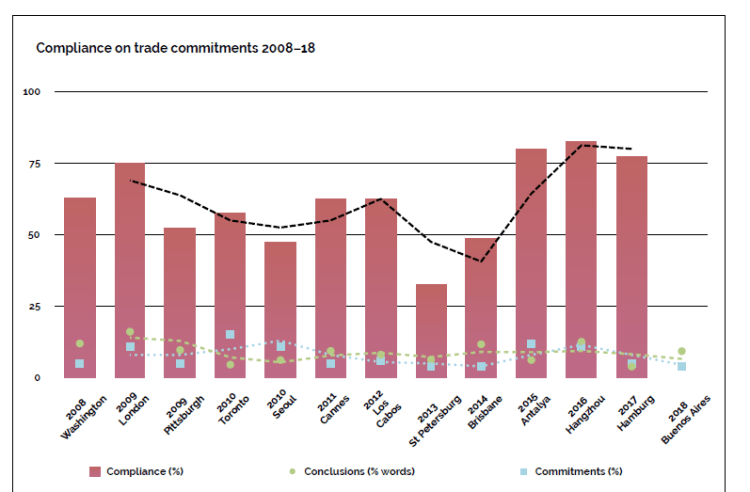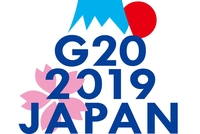Challenge
Proposal
Since the first G20 summit in 2008, G20 leaders have shown strong support for free and fair trade, although it has not always been at the top of their agenda. They have often considered international trade and investment to be engines of economic growth, productivity, innovation, job creation and development. New protectionist positions in some G20 members, led by the United States, have begun causing uncertainty in the global economy. This has forced shifts and disruptions in long-established agreements, global value chains and trade routes.
At the 2018 Buenos Aires Summit, G20 leaders could not reach a consensus on any key trade issue, except for reforming the World Trade Organization. Now the world is looking to Japan’s leadership at the G20 Osaka Summit, as Prime Minister Shinzo Abe has made the promotion of free trade a priority.
Conclusions
G20 leaders have dedicated an average of 1,087 words (9%) to trade in their communiqués at each summit. This number grew unevenly until the 2011 Cannes Summit, with 1,329 words dedicated to trade. It then dropped to 897 words (6%) at Antalya in 2015. The highest number came at Hangzhou in 2016 with 2,045 words (13%), followed by Hamburg in 2017 with 1,770 words (6%). It dropped again to 787 words (9%) at Buenos Aires in 2018.
Commitments
At their 13 summits from 2008 to 2018, G20 leaders made 169 public, collective, precise, future-oriented, politically binding commitments on trade. This amounts only to 7% of all commitments made during 10 years. Of the 169 commitments on trade, 30 referred to development, seven to digitalisation, one to climate change and none to gender.
The most trade commitments (29) came at Hamburg in 2017, while the first 2008 Washington Summit and the most recent 2018 Buenos Aires Summits, both had the least trade commitments, with five each. The number rose slowly until the 2010 Seoul Summit, with 17, when leaders focused on anti-protectionism. Then the emphasis shifted towards trade liberalisation and facilitation, with support for the multilateral trading system and the successful completion of the WTO’s Doha round.
Given the rapid growth of bilateral and regional trade agreements, at the 2013 St Petersburg Summit, the leaders issued a separate document on trade, Advancing Transparency in Regional Trade Agreements. Trade commitments grew steadily to peak in 2016 with 24 and in 2017 with 29. The five commitments made in Buenos Aires focused on WTO reform.

Compliance
The G20 Research Group has assessed members’ compliance with 20 of these trade commitments. Compliance averaged 67% – below the average of 71% across all subjects – and varied widely over 10 years. The two commitments with 90%, the highest compliance, were the 2016 endorsement of the G20 Guiding Principles for Global Investment Policymaking, and the 2015 commitment on the importance of trade for development. The lowest compliance came with commitments on anti-protectionism: –35% in 2013 and –20% in 2008. By member, the highest trade compliance came from Australia at 85%, followed by the United Kingdom, Japan and Germany at 65%.
The number of commitments on trade made at each summit strongly and positively coincides with members’ subsequent compliance. The six summits with the most trade commitments had compliance that was 36% higher than the six summits with the fewest trade commitments (results for the Buenos Aires Summit are not yet available). The 10 trade commitments with the highest compliance came at summits that had made 7% more trade commitments than the 10 trade commitments with the lowest compliance.
Corrections
A trade ministerial meeting held prior to a summit increases compliance with that summit’s trade commitments by 25%. Ministers assist with resolving trade-related issues before the summit. If they were to meet after the summit, they might accelerate implementation.
Several catalysts, which are embedded in the commitment text and provide direction for implementation, coincide with decreased compliance with that commitment: a multi-year timetable (–34%), reference to a past summit (–17%), a one-year timetable (–7%) and reference to the WTO (–6%).
At Osaka, G20 leaders could increase members’ compliance by making more trade commitments, while avoiding references to a multi-year or one-year timetable, a past summit, or the WTO. The ministerial meeting scheduled for 6 – 8 June on trade and the digital economy should also increase compliance.
G20 leaders should also emphasise the increasingly important interrelationships among trade and development, climate change, gender equality and digitalisation, including e-commerce and financial technology.
The views and opinions expressed in this article are those of the authors and do not necessarily reflect the views of the Global Solutions Initiative. This article was originally published in G20 Japan: The 2019 Osaka Summit by GT Media Group and the G20 Research Group, 2019. View the original article.








